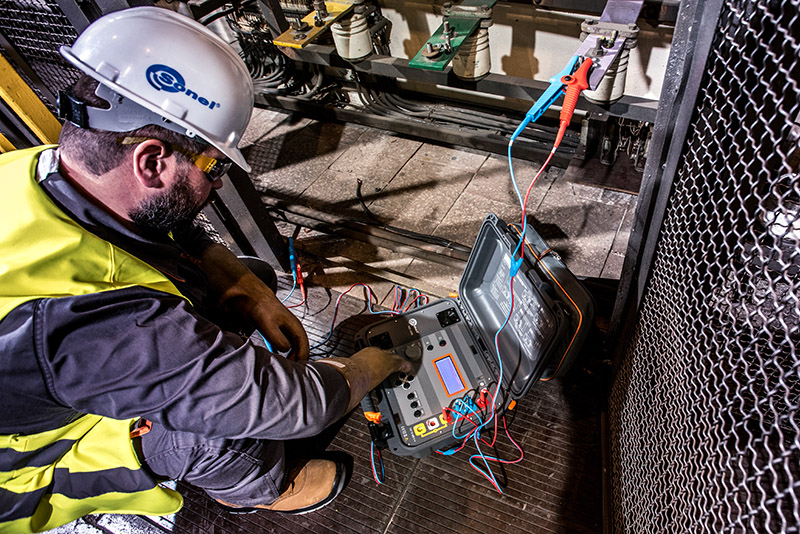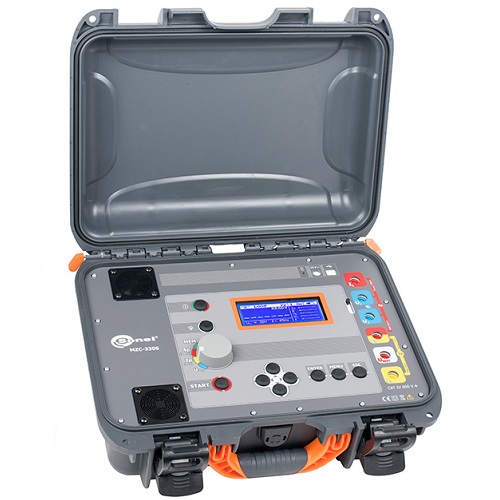Short Circuit Current Testing of Distribution Installations with High Current Fault Loop Impedance Meters
The use of electrical installations and devices may pose a risk of electric shock, especially if there is damage to the power supply circuit or the equipment powered from it. Protection of people in the immediate vicinity of electrical devices in the event of a short circuit is done by automatically disconnecting the power supply.
The normal method of verifying protection
The method of verifying whether this type of protection is installed is to check whether the current that would occur as the result of any damage would be greater than the current needed for the activation of the protection used in the circuit. The IEC60364 Part 4-41 standard specifies that disconnection of the supply in the event of a short circuit should occur within 0.4s (TN network system, 230 V – 400 V AC). The size of the current causing an automatic disconnection of power if such an event occurs is dependent on the characteristics of the fuse links or other types of fuses used.
For commonly used automatic protection devices, this verification is easy to test. For devices with a classification of B, C and D, it is 5, 10 and 20 times the nominal rated current, regardless of the device manufacturer. The actual fault current is calculated based on the measured fault loop impedance. For standard circuits, performing such a test is relatively simple and any short-circuit loop meter available on the market can be used for this purpose. The fault current will be calculated from the nominal voltage and the measured impedance. Comparison of the rated currents will then allow you to determine whether these types of protection devices are suitable or not.
The method of verifying protection in a distribution installation
However, the same type of protection is not so easy to check in distribution installations, where much higher short-circuit currents occur and therefore have much lower short-circuit loop impedances at voltages higher than 400V (e.g. 690V). Meters normally used for loop impedance measurements have a measurement range of approximately 0.13Ω upwards with a resolution of 0.01 Ω. This measurement range is completely insufficient for testing in industrial distribution networks due to the maximum permissible measurement uncertainties defined in BS:EN61557.
Therefore, for this type of measurement, SONEL S.A. has introduced two unique short-circuit loop impedance meters, the Sonel MZC-320S and Sonel MZC-330S. In order to increase the measurement resolution, along with the measurement range, these meters have short-circuit measurement circuits that allow the generation of a short-circuit current of approx. 130A for a mains voltage of 230V (measurement of a single-phase circuit) and a maximum of approx. 300A for a voltage of up to 750V (phase-phase loop measurement). The test is performed using the four-wire method, which eliminates the influence of the resistance of the test leads on the measurement result. This approach makes it possible to achieve a measurement range of 7.2mΩ with a resolution of 0.1mΩ.
In some cases, these higher measurement ranges my not be enough. This can happen for circuits with a very high short-circuit current that have very high power protection. In these situations, it may turn out that we will not be able to determine the appropriate fault current or if the condition for the automatic power disconnection will be met. In this instance, when measuring short-circuit loop impedance, the meters can also be set to measure shock and touch voltage, which allows for the installation to be tested based on voltage standards.

Fig. 1. Measurement performed with the MZC-330S short-circuit loop impedance meter.
The test equipment for verifying protection in a distribution installation
Currently, the Sonel MZC-320S and Sonel MZC-330S are the only meters in the world that can be used in networks with a rated (phase-to-phase) voltage of 500 V and 690 V. The high short-circuit currents generated during the measurement (up to 300 A) cause the release of huge amounts of energy, which in turn required the development of an innovative, efficient cooling system that guarantees up to ten measurements per minute can be made. The measurement category of these devices is Cat IV 600V according to the BS:EN 61010-1 standard.

Fig. 2. Sonel MZC-330S meter.
The meters are equipped with memory as standard and the ability to transmit data to a computer via USB or through Wi-Fi (MZC-330S). Due to their intended use, the meters are protected in a solid IP67 case. The large backlit display allows for comfortable and intuitive operation. These unique features of the Sonel MZC-320S and Sonel MZC-330S meters mean that they are the only ones in the world that can be used to measure small short-circuit loops (below 0.13 Ω) in industrial networks with phase-to-phase voltages of 500V and 690V. The measurement properties and operational functions guarantee the usefulness of these meters when measuring short-circuit loop impedance for any type of modern prosumer electrical installation that is receiving, distributing or generating power, regardless of the type of protection used.
Learn more about our products and services by visiting our Power Quality Expert product catalogue, Sonel product catalogue , Electrex product catalogue or Elspec product catalogue or you can contact us to discuss your measurement requirements further.
You can also follow Power Quality Expert on LinkedIn for regular news on products, events and technical updates.
